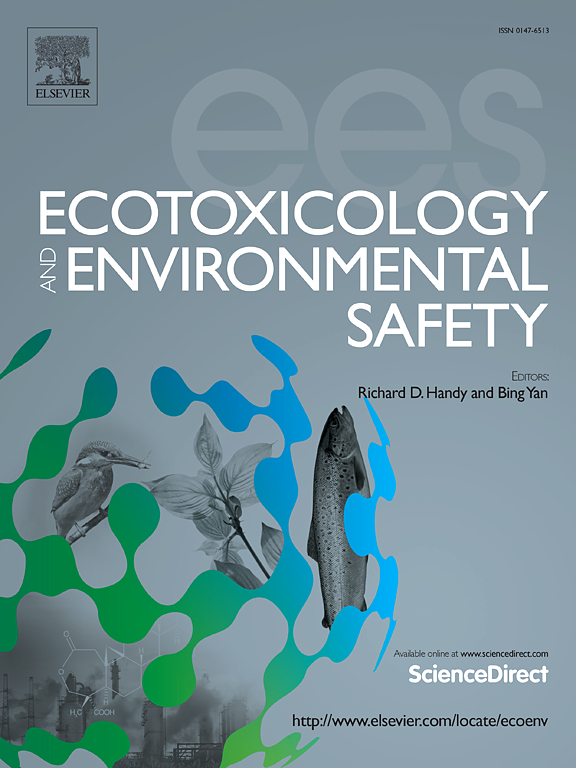低剂量聚苯乙烯微塑料暴露通过破坏肠道屏障完整性和肠道微生物群稳态增加对肥胖诱导的MASLD的易感性
IF 6.2
2区 环境科学与生态学
Q1 ENVIRONMENTAL SCIENCES
引用次数: 0
摘要
近年来,代谢功能障碍相关脂肪变性肝病(MASLD)的全球发病率激增,可能受到高能量食物摄入(如高脂肪饮食,HFD)和微塑料(MPs)等环境污染物的影响。然而,MPs暴露和HFD喂养的综合影响,特别是在长时间暴露、低浓度MPs条件下,对MASLD进展的影响仍有待充分阐明。在本研究中,C57BL/6 J雄性小鼠分别饲喂正常鼠粮和HFD,同时饲喂或不饲喂低剂量MPs(聚苯乙烯)(25-30 μg/kg体重/天),持续14周。研究人员评估了与MASLD发展相关的不良健康影响,包括肠道通透性、肠道微生物群组成、肝脏脂质代谢和肠-肝轴的介导作用。此外,有或没有低剂量MPs暴露的HFD被撤回,以进一步验证这一过程。我们的数据表明,低剂量MPs暴露或HFD喂养显著增加了肠道通透性、氧化应激、促炎反应和细胞凋亡,同时促进肠道生态失调(例如,Akkermansia水平降低)和MASLD的发展。此外,低剂量多磺酸粘多糖暴露与高热量食物喂养一起加剧了这些影响,表现出“双重打击”效应。值得注意的是,低剂量多磺酸粘多糖暴露联合高热量食物喂养对MASLD的影响在停药两周后很难逆转,这可能是由于肠道屏障完整性和肠道微生物群稳态的恢复潜力有限。这些发现强调了避免MPs暴露在MASLD发病机制中的重要性,特别是在代谢紊乱的情况下,并为开发对抗MPs暴露引起的MASLD的治疗策略提供了有价值的见解。本文章由计算机程序翻译,如有差异,请以英文原文为准。
Low-dose polystyrene microplastics exposure increases susceptibility to obesity-induced MASLD via disrupting intestinal barrier integrity and gut microbiota homeostasis
The global incidence of metabolic dysfunction-associated steatotic liver disease (MASLD) has surged in recent years, potentially impacted by both high-energy food intake (e.g., high-fat diet, HFD) and environmental pollutants like microplastics (MPs). However, the combined impacts of MPs exposure and HFD feeding, particularly under long-time exposure, low concentrations MPs conditions, on the MASLD progression remain to be fully elucidated. In this study, C57BL/6 J male mice were fed either a normal chow diet or HFD with or without low-dose MPs (polystyrene) exposure (25–30 μg/kg body weight /day) for 14 weeks. The adverse health effects associated with MASLD development were evaluated, including intestinal permeability, gut microbiota composition, hepatic lipid metabolism, and the mediating role of the gut-liver axis. Additionally, HFD with or without low-dose MPs exposure was withdrawn to further verify this process. Our data demonstrated that low-dose MPs exposure or HFD feeding significantly increased the gut permeability, oxidative stress, pro-inflammatory response and apoptosis, while concurrently contributing to gut dysbiosis (e.g., reduced levels of Akkermansia) and MASLD development. Furthermore, low-dose MPs exposure exacerbated these effects in combination with HFD feeding, exhibiting a ‘double hit’ effect. Notably, the impacts of low-dose MPs exposure combined with HFD feeding on MASLD were difficult to reverse after two weeks withdrawing, likely due to the limited recovery potential of intestinal barrier integrity and gut microbiota homeostasis. These finding underscore the importance of avoiding MPs exposure in the pathogenesis of MASLD, particularly under a metabolic disorder conditions, and provide valuable insights for the developing therapeutic strategies to combat MASLD caused by MPs exposure.
求助全文
通过发布文献求助,成功后即可免费获取论文全文。
去求助
来源期刊
CiteScore
12.10
自引率
5.90%
发文量
1234
审稿时长
88 days
期刊介绍:
Ecotoxicology and Environmental Safety is a multi-disciplinary journal that focuses on understanding the exposure and effects of environmental contamination on organisms including human health. The scope of the journal covers three main themes. The topics within these themes, indicated below, include (but are not limited to) the following: Ecotoxicology、Environmental Chemistry、Environmental Safety etc.

 求助内容:
求助内容: 应助结果提醒方式:
应助结果提醒方式:


